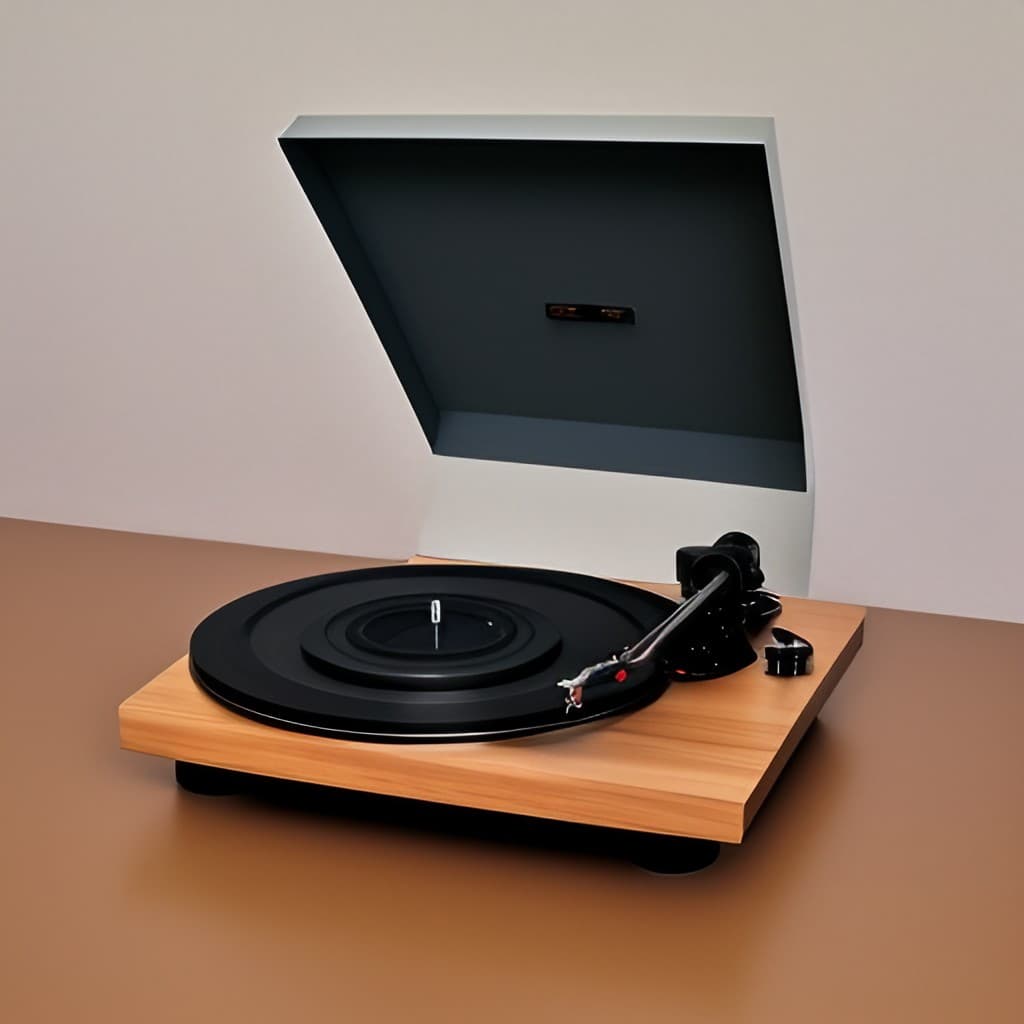What Is a Direct Drive Turntable?
Direct drive turntables are an important tool for DJs, audiophiles and music lovers alike. A direct drive turntable is a special type of turntable that uses a motor to spin the platter directly instead of using a belt or other transmission.
They offer several advantages compared to belt-drive turntables, making them popular among DJs and vinyl aficionados.
In this article, we’ll discuss the basics of direct drive turntables, their advantages and disadvantages, and the different types available on the market.
Direct drive turntables

1. Basic functioning
Direct drive turntables use a motor that is directly connected to the platter to spin it at a consistent speed.
This eliminates the need for belts or other transmissions, making them reliable and more precise when compared to belt-drive turntables.
When powered on, the motor will slowly accelerate until it reaches the desired speed, usually 33 1/3 or 45 rpm.
2. Advantages and Disadvantages
The advantages of direct drive turntables are numerous. Thanks to their lack of transmission, they have fewer moving parts that can break down, making them much more reliable than belt-drive turntables.
Additionally, because the motor is directly connected to the platter, it will spin at a more consistent speed and have better torque than belt-drive turntables.
The direct drive system also allows DJs to scratch and back cue records, as well as use pitch control for tempo adjustments.
On the downside, they are often more expensive than their belt-drive counterparts and require more power to operate.
Key components of a direct drive turntable
A. Platter
The platter is a round, flat disk that sits on top of the motor and holds the record in place. Its primary function is to rotate the vinyl at a consistent speed so that the needle can pick up sound from it.
The material and design of platters vary from model to model; some are made with aluminum, rubber, or even wood. The design of the platter also makes a difference; some have raised edges on the outer rim to reduce record slipping and improve sound quality.
B. Motor
The motor is a powerful electric engine that is connected directly to the platter in direct drive turntables. It provides consistent torque to spin the platter at either 33 1/3 or 45 rpm.
Direct drive turntables use technology called “direct-drive”, which means that the motor is connected directly to the platter instead of through a belt or other transmission.
This makes them incredibly reliable and precise when compared to belt-driven turntables.
C. Tonearm
The tonearm is a long metal arm with a needle attached to the end. Its primary function is to hold the stylus in place and follow the grooves of the record as it spins.
There are several types of tonearms, including straight arms, s-shaped arms, and linear tracking arms. They are typically made of aluminum, carbon fiber, or other lightweight materials.
D. Cartridge and stylus
The cartridge is a small device that holds the stylus in place on the tonearm. It converts vibrations from the record grooves into electrical signals which are then amplified by the turntable’s speakers.
There are two types of cartridges – moving magnet and moving coil – each of which is compatible with different types of styli. The stylus, also known as a needle, is the part that fits into the record grooves and picks up sound.
They come in several shapes and sizes; some are better suited for scratching or back-cueing while others are designed specifically for listening.
Furthermore, the material of the stylus can affect its performance; diamond tips provide better audio quality but are more prone to wear and tear.
Notable brands and products in the direct drive turntable market
A. Technics
Technics is a well-known brand in the DJ and audiophile communities. Their direct drive turntable lineup includes the SL-1200MK7, SL-1210M5G, and SL-1500C models.
All of them feature powerful motors with precise pitch control and adjustable torque settings for improved performance.
The platter is made of aluminum for greater durability, and the tonearm is designed with optimal tracking in mind.
In addition, they are all equipped with a detachable phono cable so that you can connect to a preamp or amplifier without any hassle.
B. Pioneer DJ
Pioneer DJ’s direct drive turntable lineup includes the PLX-1000, PLX-500, and DDJ-1000SRT. The PLX-1000 features a powerful motor that provides consistent torque to spin the platter at 33 1/3 or 45 rpm with precision pitch control.
Additionally, it has adjustable digital settings for improved sound quality and performance. The tonearm is designed with optimal tracking in mind, and the platter is made of aluminum for durability.
C. Audio-Technica
Audio-Technica’s direct drive turntable lineup includes the AT-LP120XUSB, AT-LP60XUSB, and AT-LP3 models. All of them feature powerful motors with adjustable torque settings, precise pitch control, and a high-precision tonearm for optimal tracking.
The AT-LP120XUSB has a USB output that lets you connect to computers and other devices, while the others have RCA outputs. In addition, they are all equipped with anti-skate systems to reduce record slipping and improve sound quality.
D. Comparison and Contrast of these Brands and their Products
All of the direct drive turntables from Technics, Pioneer DJ, and Audio-Technica provide a reliable and precise performance.
However, there are some differences between them in terms of features and quality. For example, Technics models have adjustable digital settings for improved sound quality, while Pioneer DJ models have detachable phono cables.
Audio-Technica models offer USB outputs and anti-skate systems for improved control, while the other two do not. Furthermore, the tonearms on Technics models are designed with optimal tracking in mind, while the others may lack this feature.
Popular direct drive turntable setups
A. For Hobbyists
A typical hobbyist direct drive turntable setup includes a turntable, cartridge, stylus, audio interface or sound card, and headphones/speakers.
The turntable is the main unit in this setup and is used to play records at different speeds. It is important to choose one with adjustable torque settings for better control and precision.
The cartridge is the element that attaches to the tonearm and converts the mechanical vibrations produced by the record grooves into electrical signals.
It should be chosen based on its compatibility with your stylus and desired sound quality.
The stylus, also known as a needle, is the part that fits into the record grooves and creates vibrations that can be converted to sound.
The audio interface or sound card converts these analog signals into digital signals for use with modern devices such as computers and smartphones, while headphones/speakers allow you to listen to your music.
B. For Professionals
A typical professional direct drive turntable setup includes a turntable, cartridge, stylus, DJ mixer, and speakers/headphones. The turntable should have adjustable torque settings for better control and precision when playing records at different speeds.
The cartridge is the element that attaches to the tonearm and converts the mechanical vibrations produced by the record grooves into electrical signals.
It should be chosen based on its compatibility with your stylus and desired sound quality. The stylus, also known as a needle, is the part that fits into the record grooves and creates vibrations that can be converted to sound.
FAQs
What is the difference between a direct drive and belt drive turntable?
The main difference between a direct drive and belt drive turntable is in the way the motor powers the platter, or spinning surface. A direct drive turntable has its motor directly connected to the platter, which enables it to start and stop quickly with precise control. On the other hand, a belt drive turntable uses a belt to transfer power from the motor to the platter, which provides better sound isolation but takes longer to start and stop.
Why would someone choose a direct drive turntable over a belt drive turntable?
Direct drive turntables are preferred by DJs and audiophiles because of their fast start-up times, precise control, and improved sound quality. They are also more reliable than most belt drive turntables, making them a popular choice for professional use.
How do I properly maintain a direct drive turntable?
To maintain a direct drive turntable properly you should regularly clean the stylus and tonearm, lubricate any moving parts, adjust the counterweight and anti-skating force, and check the torque settings to ensure they are correct. You should also periodically check the condition of the belt and lubricate it if necessary.
Are direct drive turntables suitable for beginner DJs and audiophiles?
Direct drive turntables are suitable for both beginner DJs and audiophiles, as they offer precise control and improved sound quality over other types of turntables.
Can a direct drive turntable be upgraded or customized?
Yes, direct drive turntables can be upgraded or customized with aftermarket components such as a better cartridge, stylus, and tonearm to further improve sound quality. Additionally, many direct drive turntables have built-in preamps that can be upgraded for better sound.
Conclusion
Direct drive turntables are a popular choice for both DJs and audiophiles, offering precise control over their sound.
They provide improved sound quality over other types of turntables and can also be upgraded or customized with aftermarket components to further improve their performance.
It is important to understand the basics of direct drive turntable technology before making a purchase, as there are many factors to consider such as torque settings, stylus type, and tonearm length.
With the right knowledge and research, you can find the perfect direct drive turntable for your needs.







